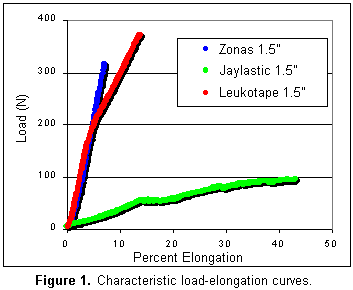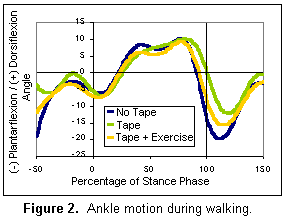STATEMENT OF PURPOSE:
This project was divided into two distinct phases. The purpose of Phase I was to determine differences in the rheological, or time-dependent, properties between three athletic tapes, each designed for a different purpose, using mechanical tests. The purpose of Phase II was to attempt to correlate these time-dependent mechanical parameters with exercise-induced changes in kinematic properties of the taped ankle using gait testing.
SIGNIFICANCE:
Athletic tape is used to restrict
excessive joint motion for athletes in a wide range of sports, from football
to gymnastics. Yearly, vasts amounts of money is invested in athletic
tape for the prevention of injury, yet it has been commonly reported that
it loses much of its structural support after about 20 minutes of exercise.
While many studies have addressed the functional performance characteristics
of athletic tape, its mechanical properties and their physiological relevance
are poorly understood. This project attempts to bridge this gap.
DESCRIPTION OF METHOD:
The tapes studied in this project were selected
using a web-based survey of athletic trainers at the professional and collegiate
level. The three tapes chosen were Zonas (Johnson & Johnson),
the typical white athletic tape used by most trainers for both prophylaxis
and rehabilitation; Jaylastic (Jaybird & Mais), the elastic adhesive
tape used primarily for support in the case of an injury; and Leukotape,
a specialty tape designed specifically for medical purposes such as patellar
tracking and arch support.
 In Phase I, each tape was subjected to three modes of testing: load
to failure, fatigue under load control, and fatigue under displacement
control. After the fatigue tests, the tapes were loaded to failure
for comparison with the pre-cycling failure tests.
In Phase I, each tape was subjected to three modes of testing: load
to failure, fatigue under load control, and fatigue under displacement
control. After the fatigue tests, the tapes were loaded to failure
for comparison with the pre-cycling failure tests.
In Phase II, gait analysis using reflective markers
and a force plate was performed on a single subject taped with Zonas to
identify target parameters to compare with the mechanical test results.
The subject was gait tested before and after a rigorous 20 minute exercise
protocol, both with and without tape.
MAIN FINDINGS:
In Phase I, load to failure tests (Figure 1) were
able to detect significant differences (p<0.001) in failure load, elongation
at failure, and stiffness between tapes. Cyclic response data from
fatigue tests under both load and displacement control were quantified
by calculating logarithmic rate parameters from curve fits. Parameters
from displacement control fatigue tests were independent of the loading
conditions and significantly different between tapes (p<0.001).
After cycling, tapes loaded to failure showed increased stiffness (p<0.001),
but no significant  changes
in failure load or elongation to failure. In each case, Jaylastic
was most sensitive to cycling, and Zonas was the least sensitive.
changes
in failure load or elongation to failure. In each case, Jaylastic
was most sensitive to cycling, and Zonas was the least sensitive.
In Phase II, ankle range of motion (peak dorsiflexion
to peak plantarflexion) was identified to be the variable most sensitive
to the different taping conditions. Relative to the no tape condition,
tape resulted in an initial reduction in ankle range of motion (ROM) of
25.4% in walking and 26.7% in jogging. Twenty minutes of exercise
with the tape reduced these percentages to 16.7% in walking and 20.6% in
jogging. Figure 2 depicts the results of the walking gait tests.
Interestingly, the largest difference in these curves occurs during swing
phase (approximately 110% of stance phase in the figure).
CONCLUSIONS:
The mechanical tests performed in this study were
successful in distinguishing between time-dependent parameters of three
existing tapes. The results of these tests can now be used as benchmarks
with which to compare the results of future mechanical tests of athletic
tape.
The dynamic gait tests have been useful in identifying
peak dorsi-/plantarflexion range of motion as a target parameter for correlation
with the time-dependent mechanical parameters. Gait testing will
be continued to test more subjects and to include the other tapes.